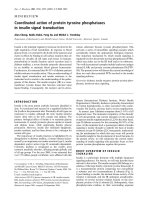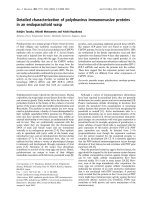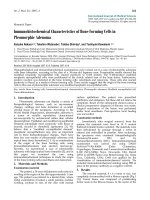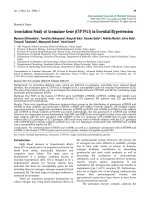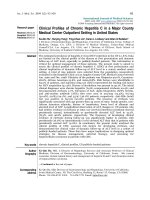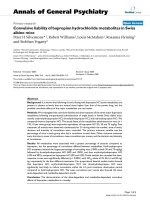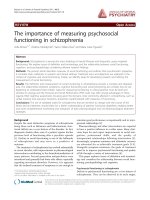Báo cáo y học: " Mental health of female foreign spouses in transnational marriages in southern Taiwa" docx
Bạn đang xem bản rút gọn của tài liệu. Xem và tải ngay bản đầy đủ của tài liệu tại đây (226.4 KB, 9 trang )
RESEARC H ARTIC LE Open Access
Mental health of female foreign spouses in
transnational marriages in southern Taiwan
Bih-Ching Shu
1
, For-Wey Lung
2,3,4,5*
, Ching-Hsien Chen
6
Abstract
Background: The aim of this study was to investigate the mental health status, and the risk factors associated with
mild psychiatric disorders, of female foreign spouses (from Vietnam, Indonesia, and mainland China) in southern
Taiwan, and to understand the mental health needs of these women.
Methods: One hundred and twenty nine participants were willing to participate in this study. All participants
fulfilled all questionnaires which included demographic informa tion, the Chinese Health Questionnaire (CHQ), the
Eysenck Personality Questionnaire (EPQ), and the Mental Health Care Needs Questionnaire (MHCNQ).
Results: By multiple linear regression, neuroticism characteristics (p = 0.000), the dimension of knowledge of the
level of their own psychological disturbanc e (p = 0.001), dimension of friends assistance (p = 0.033), and dimension
of religion comfort (p = 0.041) in mental health care needs could be used to predict possible mild psychiatric
disorders. Furthermore, SEM model showed that Indonesian or Vietnamese spouses have more likely degree in
mental health care needs (b = -0.24, p = 0.003), compared with Chinese ones. A higher level of neuroticism was
associated with a greater likelihood of mild psychiatric disorder (b = 0.54, p < 0.001), and of mental health care
needs (b = 0.21, p = 0.013). A higher degree of mental health care needs was related to a greater likelihood of
mild psychiatric disorder (b = 0.14, p = 0.05).
Conclusion: In conclusion, we have obtained a better understanding of the mental health status of female foreign
spouses in transnational marriages, who face many difficulties. Indonesian or Vietnamese spouses tend to more
likely degree in mental health care needs than Chinese spouses, and then indirectly influenced their mental health
status. Some individuals with a neurot ic personality are exposed to high risk and might suffer from mild psychiatric
symptoms. The needs for psychological counseling and religion therapy were the first priority for these women,
particularly the Indonesian and Vietnamese spouses. From these findings, we have a better understanding of how
to assist these female foreign spouses in future.
Background
As a result of globalization, the number of individuals
who travel, work or study abroad is increasing, along
with the number of transnational marriages. According
to the United Nations [1], approximately half (49.6%) of
the 200 million international migrants in 2005 were
women. The UN has argued that globalization opens up
a rather personal market of emotional relationships and
marriages. Hence, the phenomenon of “ mail-order
brides” has become an importa nt route for international
migration, and the number of women from poor
countries who have married men from more developed
countries has increased. As a result, the number of mar-
riage bureaus and matchmaking agencies has also risen.
Recently, there has been a dramatic rise in the number
of “mail-order brides” who have been provided through
matchmaking agencies.
Today, cross-border marriages seem to be an alterna-
tive to poverty and starvation. Foreign brides usually
come from countries such as I ndonesia, the Philippines,
Vietnam, and Thailand. Since the 1970s, such women
have married men from the more affluent Western
world, from countries that promise them a better life
and a stable future, such as the United States, Canada,
and Europe. In Asia, the recruitment of foreign brides
* Correspondence:
2
Department of Psychiatry, Kaohsiung Armed Forces General Hospital,
Kaohsiung, Taiwan
Full list of author information is available at the end of the article
Shu et al. BMC Psychiatry 2011, 11:4
/>© 2011 Shu et al; licensee BioMed Central Ltd. This is an Open Access article distribute d under the terms of the Crea tive Commons
Attribution License ( which pe rmits unrestricted use, distribution, and reproduction in
any medium, provided the or iginal wor k is properly cited.
has been increasing in Japan, Korea, Hong Kong, and
Taiwan since the 1990s.
In 2006, one in every five marriages in Taiwan was
transnational [2], and 89% of the foreign spouses
involved were female. The majority of these female for-
eign spouses originated from countries in Southeastern
Asia, including Vietnam and Indonesia. Such marriages
were arranged predominantly through a commercial
marriage agent [1]. The most common reason given for
the decision to marry a foreign husband was economic
stability (58%), becau se the marriage enables the woman
to relocate and to obtain a higher social status and qual-
ity of life [ 3]. The other reasons included: to obtain a
visa (16%), love (16%), curiosity about living in a foreign
land (5%), an escape from family problems, and so on.
The impact of a transnational marriage on the relo-
cated spouse includes changes in culture, language, role,
and interpersonal interactions. According to Helman
[4], culture is a set of guidelines that individuals inherit
as members of a particular society. It tells them how to
view the world, how to experience it emotionally, and
how to behave in the world in relation to other people,
to supernatural forces or gods, and to the natural envir-
onment. The context of culture comprises historical,
economic, social, political, and geographical elements.
Thus, the different cultural backgrounds of people from
different countries might cause them to think, experi-
ence life, and behave differently. As a result, a move to
another country is an important event for people, and it
can alter their life dramatically.
Marriage, which is a big step in the life of an indivi-
dual, also creates a new scenario in which the partners
must adjust to their new roles. Female foreign spouses
in Taiwan not only face the stress of immigration, but
also have to cope with the cultural demands of their
husband’s family. In general, female foreign spouses go
to more a ffluent countries, such as Japan, Hong Kong,
Korea,andTaiwan,togainabetterlifeandamore
stable future. These countries, including Taiwan, actively
promote cross-border marriages and encourage the nat-
uralization of foreign spouses in order to ensure a
healthy productive line that will serve the needs and
interests of neoliberal globalization [3].
Shu and colleagues interviewed 19 female foreign
spouses and found them to have difficulties in adjust-
ment to their new life in Taiwan [5]. The major themes
raised regarding their living experience were: difficulty
in finding a sense of belonging, children being the cen-
ter of their life, and children being under pressure
because of the insecurity and loneliness of their mother.
Becoming a mother needs many more resources, and
social networks are required to support the development
of women emotionally, socially, psychologically, and cul-
turally, while they develop their abilities as competent
mothers. The need both to adjust to an alien culture
and to serve as a mother causes foreign mothers to suf-
fer from more pressures and conflicts than local
mothers. Hence, the role of mental health services is
very important in these populations, because mental
health problems might result from these pressures [6-8].
Kuan suggested that the health and well-being of
female foreign spouses is a critical issue [9]. Further-
more, the social, cultural, and economic adjustment
required during the process of adaptation can be stress-
ful. Immigration has been linked to mental health, but
the nature of the association has changed over time.
Early notions of immigration and mental health were
built on the premise that people e ncounter difficulties
and obstacles as they settle into a new society [10]. The
cultural differences not only cause mental disability, but
they also contribute to other problems, including diffi-
culties in interpersonal relationships with partners and
others [11]. Integration, and the adjustment to a new
relationship and a new environment, can affect the
health of a n individual. Cultural differences, changes in
life pattern, a nd feelings of hopelessness are risk f actors
for deviations from health. When immigrants have diffi-
culty in adapting to new social and cultural norms,
mental health problems such as depression, schizophr e-
nia, and anxiety can be manifested [12,13].
However, despite the increasing visibility of transna-
tional female foreign spouses in communities across the
island of Taiwan, little is understood about their health,
especially their mental health. The lac k of health data
about these women has become a critical issue as health
careproviderstrytobecomeresponsivetothepressing
needs of female foreign spouses who come from differ-
ent cultures and potentially speak or read little or no
Chinese. In order to help these female foreign spouses
to adjust, it is necessary to understand better the experi-
ences and concerns of these women, who bring their
own cultural backgrounds, perceptions, and experiences
into the homes of their husbands in Taiwan. Therefore,
an understanding of the health care needs and mental
health, as well as its related factors, of this specific
group in Taiwan is an important issue for mental health
nurses.
The specific aims of this study were: (1) to inv estigate
the mental health status, as well as factors related to
mental health, of female foreign spouses from Vietnam,
Indonesia, and mainland China in transnational mar-
riages, and (2) to understand the mental health care
needs of these women.
Methods
Participants
The inclusion criteria for participants were: (1) indivi-
duals who had immigrated to Taiwan for marriage and
Shu et al. BMC Psychiatry 2011, 11:4
/>Page 2 of 9
whose nationalities were Indonesian, Vietnamese or Chi-
nese; (2) age between 20 and 50 years; (3) the ability to
comprehend Indonesian, Vietnamese, Mandarin, Taiwa-
nese (Hokkien), Haka or Engl ish. The exclusion criter-
ionwasresidenceintheircountryoforiginformore
than 6 months of each year. The participants of the
study were recruited from Pingtung County in southern
Taiwan. The researcher began by contacting foreign
mothers who brought their children for routine health
checks in the local health center agencies. Afterwards, a
larger number of qualifying foreign spouses were
recruited through snowballing. Participants and their
families were informed of the research procedures, the
duration of the study, and that all the data provided
would be anonymous. If they agreed to participate in
the study, they gave written informed consent. The
study was approved by the IRB of National Cheng Kung
University Hospital. In order to ensure the validity of
the data collected, the data collectors were trained to
cultivate cultural sensitivity and culturally appropriate
care ability. Three types of questionnaire were com-
pleted and the demographic details of the participants
were collected at their home by a trained researcher.
Outcome Measures
Four questionnaires were used to collect data.
1. Demographic information
The information included the participant’sage,marital
status, level of education, family income, and attendance
at a Chinese language program, and the ethnicity of
their husband.
2. The Eysenck Personality Questionnaire (EPQ)
The EPQ was developed initially by Eysenck and
Eysenck [14]. It consists of four subscales: psychoticism,
extraversion, neuroticism, and the lie sca le. The Chinese
version of the EPQ was modified by Lu [15]. It elicits 25
items and has two subscales, extraversion and neuroti-
cism. A Cronbach’s a of 0.90 and good validity have
been demonstrated [15].
3. The Chinese Health Questionnaire-12 (CHQ-12)
The present study used the Chinese Health Questionnaire
(CHQ) to assess the psychological well-being of the parti-
cipants. The CHQ [16] is a modified version of Goldberg’s
General Health Questionnaire (GHQ) [17]. The scale has
a weighted classification, sensitivity, and specificity of 89%,
70%, and 95%, respectively [18]. The CHQ has a Cron-
bach’s a of 0.84 [19]. There are fo ur possible answers for
each item: answers that correspond to “not at all” or
“about as usual” are scored “0”, whereas those that corr e-
spond to “more than usual” and “strong feeling” are scored
1. A total score of 12 points is possible. A higher score
indicates that the psychological well-being of the indivi-
dual is lower. The optimum cutoff point (the best compro-
mise between high sensitivity and a low false-positive rate)
is 3/4 from t he Receiv er Operating Characte rist ic (ROC)
curves [20]. Cheng et al. [19] demonstrated an internal
consistency of 0.79 for the CHQ.
4. The Mental Health Care Needs Questionnaire (MHCNQ)
This was developed by Shu et al. [5] and is based on
previous interviews of foreign spouses and a literature
review. There are eight items with five-point Likert scale
responses. These items assess the need for: (1) knowl-
edge of t he level of th eir own ps ychological disturbance,
(2) health professionals or medical services, (3) psycho-
logical professional services, (4) family assistance, (5)
assistance from friends, (6) community assistance, (7)
comfort from religion, and (8 ) folk therapy (such as for-
tune telling). A higher score indicates a greater need for
health care.
The four measures (demographic information, EPQ,
CHQ,andMHCNO)weretranslatedintoVietnamese
and Indonesian using the following procedures. Firstly,
two bilingual translators translated the Chinese versions
of the four measures into Vietnamese or Indonesian.
Then, the draft version was given to two Vietnamese
and three Indonesian female foreign spouses for pre-
testing, and has made some corrections based on their
advice. The final translated and original versions were
completed by two bilingual Vietnamese and Indonesian
transnational spouses with equivalent results (100%).
These procedures ensured the applicability of the four
questionnaires in Viet nameseandIndonesianinorder
to avoid language and cultural bias.
Statistical Analysis
The data were analyzed using the SPSS 17.0 for Win-
dows software package (SPSS,Chicago,IL,USA).In
addition, the cut-off points of all possible indexes were
assessed using receiver operating characteristic (ROC)
analysis, which is a meth od to measure the ability of an
observer to identify a signal against a background of
noise [21]. In addition, structural equation modeling
(SEM) was performed using the AMOS 7.0 software
packageforWindows(SPSS,Chicago,IL,USA).SEM
uses the chi-square fit test to investigate the overall fit
of the model. P values greater than 0.05 and an adjusted
goodness-of-fit (AGFI) greater than 0.90 with a root
mean square error of approximation (RMSEA) of 0.05
(0.08) or less indicated that the model adequately
described the observed data.
Results
Demographic Characteristics
In total, 129 femal e foreign spouses, 41 from Indonesia,
45 from Vietnam, and 43 from mainland China, com-
pleted the questionnaires. There were significant differ-
ences with respect to age (c
2
= 29.4, p <0.005)among
the three groups. Seventy-eight percent of the
Shu et al. BMC Psychiatry 2011, 11:4
/>Page 3 of 9
Vietnamese women were aged b etween 20 and 30 years,
the Indonesians were predominantly between 26 and 35
years, and the Chinese participants between 31 and 35
years. On average, the Vietnamese spouses were the
youngest of the study group. The period of time since the
women had immigrated to Taiwan was also significantly
different among the three groups. A greater proportion
of women from Indonesia and mainland China than from
Vietnam had immigrated more than five years ago (76.2%
and 82.9%, respectively, vs. 47.7%). Almost all the women
from the three groups remained in their original marriage
(p > 0.05). The level of education in the country of origin,
attendance at a Chinese language program, ability to
communicate , rel igion, and number of children were sig-
nificantly different among the three groups (p < 0.001).
The Indonesian women had, on average, received more
years of education in their country of origin than those
from Vietnam or China. In general, they could under-
stand some Chinese and had a basic ability to speak the
language. In contrast, more than half of the Vietnamese
participants did not attend a Chinese language program.
Spouses from mainland China, who spoke a similar lan-
guage to that spoken in Taiwan, expressed no need to
attend a Chinese program. The basic demographic infor-
mation is shown in Table 1.
CHQ among the three groups
The Indonesian spouses attained the highest mean score
on the CHQ (mean = 2.35, SD = 2.81). However, there
were no statistically significant differences among the
three groups by ANOVA (Table 2). If a cut-off score on
the CHQ of 3 points was used, 35.4% of Indonesian
spouses and 28.9% of Vietnamese spouses showed possi-
ble psychological distress; 27.5% of Indonesian spouses
and 20.0% of Vietnamese spouses had a possible mild
psychiatric disorder if a CHQ cut-off score of 4 points
was used (Table 3).
Health care needs among the three groups
With regard to the health care needs of the participants,
although there w as no signi ficant diff erence amon g the
threegroups,thepriorityoftheirneedswasalmostthe
same. The need for f amily assistance was ranked at the
top, followed by the need to know the level of their own
psychological disturbance. Theassistanceoffriendswas
ranked third and the need for professional health services
fourth. However, the Chinese group showed the fewest
needs, according to the MHCNQ questionnaire (Table 4).
Factors related to CHQ
Demographics (age, education level, communication
skills, number of years in Taiwan and so on), personality
characteristics, and mental health care needs were ana-
lyzed using multiple linear regression to investigate
which factors were predictive of possible mild psychiatric
disorders in female foreign spouses. The results showed
that neuroticism characteristics (p = 0.000), the dimen-
sion of knowledge of the level of their own psyc holo gica l
disturbance (p = 0.001), dimension of friends assistance
(p = 0.033), and dimension of religion comfort (p =
0.041) in mental health care needs could be used to pre-
dict the mental symptoms in female foreign spouses. The
results are shown in Table 5. A higher level of neuroti-
cism characteristics, higher degree of mental health care
needs in knowledge of the level of their own psychologi-
cal disturbance dimension, assistance from friends
dimension and reli gion comfort dimension would
coursed greater likelihood of mild psychiatric disorders.
Receiver operating characteristic (ROC) analysis
The optimum cut-off points for the score of neuroticism
obtained from the ROC curv e were calculated to be 4/5
(area under curve = 0.689). The sensitivity was 58.8%,
specificity 70.4%, positive predictive value (PPV) 88.2%,
and the negative predictive value (NPV) was 31.1%.
Structural equation model (SEM)
The SEM was used to explore further the associations
and interactions between neuroticism, mental health care
needs and mental health among female foreign spouses.
The parsi monious SE M resulted in a p value of 0.383,
AGFI of 0.963 and RMSEA of 0.000, thus showing
that the model a ccurately described the observ ed data
(Figure 1). The dummy group was divided into female
foreign spouses whose nationalities were Chinese, and
whose nationalities were Indonesian or Vi etnamese.
Indonesian or Vietnamese female foreign spouses pre-
sented higher degree in mental health care needs (b =
-0.24, p = 0 .003), comp ared wit h Chinese participants,
and then further indirectly influenced their mental health
status. A higher level of neuroticism was associated with
a greater likelihood of mild psychiatric disorder (b = 0.54,
p < 0.001), and a higher degree of mental health care
needs (b =0.21,p = 0.013). Moreover, a higher degree of
mental health care needs was related to a greater likeli-
hood of mild psychiatric disorder (b =0.14,p =0.05).
Particularly, the dimension of knowledge of the level of
their own psychological disturbance (p = 0.01), dimen-
sion of psychological professional services (p = 0.05),
dimension of religion comfort (p = 0.04), and dimension
of folk therapy (p = 0.01) were mai n contributing factors
of mental health care needs to increasing mild psychiatric
disorders among groups (data not shown). The variance
of mild psychiatric disorder was 35%.
Discussion
This study provides valuable information on the mental
health status of female foreign spouses in transna tional
Shu et al. BMC Psychiatry 2011, 11:4
/>Page 4 of 9
Table 1 Demographics of female foreign spouses in transnational marriages (n = 129)
Vietnamese (n = 45) n
(%)
Chinese (n = 43) n
(%)
Indonesian (n = 41) n
(%)
chi-square p
value
1. Age 29.41
20-25 18 (40.0) 2 (4.7) 5 (12.8) 0.000
26-30 17 (37.8) 10 (23.3) 14 (35.9)
31-35 4 (8.9) 18 (41.9) 10 (25.6)
> 36 6 (13.3) 13 (30.2) 10 (25.6)
2. Time since immigration to Taiwan (years) 13.91
< 5 23 (52.3) 10 (23.8) 7 (17.1) 0.001
> 5 21 (47.7) 32 (76.2) 34 (82.9)
3. Marital status 1.15
Married 43 (95.6) 38 (90.5) 39 (95.1) 0.563
Single 2 (4.4) 4 (9.5) 2 (4.9)
4. Education level in Homeland 17.63
< 6 years 17(37.8) 2(4.7) 14(34.1) 0.001
6~9 years 17(37.8) 17 (39.5) 14 (34.1)
> 9 years 11(24.4) 24 (55.8) 13 (31.7)
5. Attendance at Chinese literacy program in
Taiwan
36.47
None 19 (42.2) 37 (92.5) 12 (29.3) 0.000
Literacy classes or supplement school 26 (57.8) 3 (7.5) 29 (70.7)
6. Language ability before move to Taiwan 63.81
Only mother tone 41 (91.1) 2 (4.9) 0.000
Could speak Chinese, Haka or Taiwanese 4 (8.9) 39 (95.1)
7. Taiwanese or Haka ability (listening and
speaking)
26.70
Very good 21 (48.4) 39 (92.9) 34 (82.9) 0.000
Poor 19 (44.2) 3 (7.1) 4 (9.8)
Neither 3 (7.0) 0 (0) 3 (7.3)
8. Mandarin ability (listening and speaking) 0.352
a
Very good 38 (86.4) 38 (92.7) 0.486
Poor 4 (13.6) 3 (7.3)
9. Religion 30.54
None 7 (15.6) 21 (48.8) 0 (0.0) 0.000
Yes 38 (84.4) 22 (51.2) 40 (100.0)
10. Number of children 17.02
None 2 (4.7) 5 (11.6) 4 (9.8) 0.002
1 27 (62.8) 15 (34.9) 8 (19.5)
≧2 14 (32.6) 23 (53.5) 29 (70.7)
11. Husband’s age 4.82
< 35 9 (20.0) 6 (14.3) 3 (7.7) 0.777
35~39 10 (22.2) 9 (21.4) 8 (20.5)
40~44 13 (28.9) 9 (21.4) 10 (25.6)
45~49 9 (20.0) 11 (26.2) 12 (30.8)
> 50 4 (8.9) 7 (16.7) 6 (15.4)
11. Husband’s years of education 6.74
Less than 6 years 3 (6.8) 0 (0) 4 (9.8) 0.150
6~9 years 16 (36.4) 10 (23.8) 14 (34.1)
More than 9 years 25 (56.8) 32 (76.2) 23 (56.1)
12. Household income/monthly (NT dollars) 7.44
≦20,000 15 (48.4) 11 (29.7) 8 (32.0) 0.115
20,000-40,000 10 (32.3) 20 (54.1) 16 (64.0)
>40,000-70,000 6 (19.4) 6 (16.2) 1 (2.4)
a
Fisher’s exact test
Shu et al. BMC Psychiatry 2011, 11:4
/>Page 5 of 9
marriages in Taiwan. Mental health has become a criti-
cal issue recently in the study of female foreign spouses.
Spouses in transnational marriages are faced with the
stresses associated with being away from their country
of origin and with cross-cultural marriage. The present
paper attempts to explore the mental health issues of
these women, and to make general conclusions about
their adjustment after immigration. This study also
examined and identified various needs in relation to
mental health. Furthermore, personality and mental
health care needs factors were also found to be the
potential threat to mental health.
Common problems, such as cultural adaptation, eco-
nomic and language difficulties, and a lack of social sup-
port and ethnic identity, might mean that women in
transnational marriages represent a high risk population
with respect to mental health. In addition, factors such
as effects on the self of family and social-cultural back-
ground might result in potential mental health problems
when individuals become maladjusted [22]. Obviously,
Chinese spouses tend to have better mental health sta-
tus and less mental health care needs than Vietnamese
or Indonesian spouses in the present study. There were
around 20% and 27% of the Vietnamese and Indonesian
spouses of this study, respectively, had a CHQ score ≥4,
which can be compared with 18% in native Taiwanese
women in our previ ous study [23]. This result indicated
that these women in the current study had poorer men-
tal health than those studied by Shu [23]. An important
issue in s ocial psychological research on mental health
is the existence of stressful life circumstances that are
rooted in the social role of the individual. Immigration
is a stre ssful life experience that leads to cultural differ-
ences and conflicts, language barriers, and economic
and societal changes, which in turn cause changes in
interpersonal relationships, values and attitudes, and
necessitates time to adjust. These changes can have
negative effects on personal health [24,25]. Due to the
similar social cultural background and language among
China and Taiwan, hence, Chinese spouses suffer less
likely psychological stress in living Taiwan, comparing
with Vietnamese or Indonesian spouses. Vietnamese or
Indonesian spouses also further need more assistance
from friends and more comfort from religion than C hi-
nese spouses.
Furthermore, it has been documented that many
immigrant wives from Southeast Asia become pregnant
soon after settling in Taiwan. Therefore, the difficulties
involved in adapting to both a new marriage and a new
culture are compounded by the challenges of giving
birth and new motherhood. Most of the marriages of
these female foreign spouses were arranged through
matchmaking agencies. The relationship with the hus-
band needs time to establish. In addition, because of the
duty to continue the bloodline of the husband, these
female foreign spouses not only face cultural differences
but must also deal with the experience of giving birth to
a baby. Although the female foreign spouses came to
Table 2 Mean CHQ scores of female foreign spouses in
the three groups (n = 127)
Mean (SD) F P
Vietnamese (n = 44) 1.78 (2.60) 2.625 0.076
Indonesian (n = 40) 2.35 (2.81)
Mainland Chinese (n = 43) 1.16 (1.48)
Table 3 The percentage of female foreign spouses with
CHQ > = 3 or 4
CHQ≧3
(Psychological
distress)
CHQ≧4
(Mild psychiatric
disorder)
Vietnamese (n = 44) 13/45 = 28.9% 9/45 = 20.0%
Indonesian (n = 40) 14/40 = 35.0% 11/40 = 27.5%
Chinese (n = 43) 6/43 = 14.0% 3/43 = 7.0%
Taiwanese native (n =
67, ref)
17.9%
Table 4 Priority of health care needs among the different
groups
Vietnamese
(n = 44)
Indonesian
(n = 40)
Chinese
(n = 43)
Total Rank
Family assistance 89 85 67 241 1
Friend assistance 65 81 61 207 2
Knowing the level of own psychological disturbance
65 83 41 189 3
Psychological professional service
63 46 32 141 4
Health professionals or medical service
57 53 25 135 5
Community
assistance
43 62 25 130 6
Religion comfort 40 48 13 101 7
Folk therapy (such as fortune telling)
39 24 5 68 8
Total 461/44 =
10.50
401/40 =
10.03
269/43 =
6.26
Table 5 Parsimonious prediction model of mental health
for female foreign spouses using total scores of CHQ
Variable B P value
Neuroticism .31 .00
Knowing the level of own psychological disturbance .54 .00
Friend assistance 32 .03
Religion comfort .43 .04
Constant 60 .22
B: regression coefficient
Shu et al. BMC Psychiatry 2011, 11:4
/>Page 6 of 9
Taiwan for a better life, in general, the social-economic
class of husbands involved in transnational marriages in
Taiwan is low. There is also a lack of social support.
Immig rants are often discriminated against, do not have
close friends, and are unemployed; these factors also
influence the indicators of depression and anxiety [26].
Good mental health implies that the individual has a
stable personality and therefore can maintain a concor-
dant relationship with the external environ ment. Mental
health is affected by social structure, culture, and
environment. The pursuit of the life task is an individual
process and relates t o personal beliefs and characteris-
tics [27]. Our study showed that female foreign spouses
with neuroticism were more likely to cause mental
health care needs and to develop mild psychiatric symp-
toms than those without neuroticism. Research has
shown that neuroticism is correlated with physical
symptoms of mental health [28].
However, we found that the female foreign spouses
did not identify their own health needs. Individuals
Neuroticism
Mental health
er
.35
Group
Mental health
care needs
.54
er
er
24
.14
.21
Figure 1 Parsimonious model of mental health, mental health care needs and neuroticism among female foreign spouses. Chi-square
= 1.921; p = .383; df = 2; GFI = .993; AGFI = .963; RMSEA = .000. Dummy group: 1 = female foreign spouses whose nationalities were Chinese;
0 = foreign spouses whose nationalities were Indonesian or Vietnamese. Mental health = total score on CHQ; Mental health care needs = total
score on MHCNQ; Neuroticism = total score for neuroticism; er = error.
Shu et al. BMC Psychiatry 2011, 11:4
/>Page 7 of 9
commonly do not seek health care if they are unaware
of their needs or do not identify the resources they
coul d claim. From the responses of the participants, the
need for assistance from the family was their first prior-
ity. The need for assistance from friends also played an
important role. The stigma of acknowledging mental
health problems poses a significant barrier to seeking
help [29]. It seems that building a basic trusting rela-
tionship with such individuals is the first step. In an
alien land, where the language, values, work atmosphere,
and patterns of socialization are different from those in
their own country, woman might become completely
lost. Using further analysis of multiple linear regressi on,
the dimensions of knowledge of the level of their own
psychological disturbance, of friends assistance, and of
religion comfort were potential threat factors in increas-
ing mild psychiatric disorders. By SEM model, the find-
ings also provided an evidence that higher degree of
mental health care needs was related to greater likeli-
hood of mild psychiatric disorder, especially the dimen-
sions of knowledge of the level of their own
psychological disturbance, of psychological professional
services, of religion comfort, and of folk therapy. As
descriptio n in the previous paragr aph, Vietnamese or
Indonesianspousestendtohavemorelikelymental
health care needs than Chinese spouses, and then
further indirectly caused more psychological stress, even
leaded more mild psychiatric disorders. From the results
of this study, we have a better understanding of how to
assist these female foreign spouses, particularly focus on
the psycho logical counseling and religion therapy in the
Indonesian and Vietnamese spouses.
The psychosocial health of female foreign spouses is
compromised not only as a consequence of having to
cope with the usual demands of new motherhood and
physical health problems but also as a result of loneliness
caused by isolation and a lack of social support [30,31].
In general, physical health is given much greater prior-
ity than mental health. These female foreign spouses
and their families did not perceive the stress of transna -
tional marriage and its effects on mental health to be a
problem. They consi dered it to be a self-inflicted abnor-
mal behavior to seek attention. Thus, an examination of
the use of mental health services by this population is
necessary.
There are some limitations of this study. Firstly, the
design lacked a control population of native Taiwanese
women. In order to reduce the effect of this limitation,
we used a previ ous study as a reference for comparison.
Secondly, we used a convenience sample. A variety of
women in transnational marriages have complicated rea-
sons for c oming to Taiwan. Therefore, it is difficult to
make generalizations from our r esults. Thirdly, the
cross-sectional design might not manifest the true
situation comprehensively. It might be necessary to
follow up the process of adaptation, adjustment, and
incorporation into society regularly.
Implication
Knowledge of these issues will help mental health nurses
and other health workers to deal effectively with female
foreign spouses in transnational marriages who originate
from Indonesia or Vietnam. Immigrant women, espe-
cial ly foreign spouses, encounter socio-econo mic, politi-
cal, and cultural problems that are imbedded in the
societies they originated from and joined. These issues
include problems related to prejudice, domestic violence,
and discrimination. How female foreign spouses cope
with and adapt to their new life and environment is
important. Many immigr ant women in Taiwan are iso-
lated because they do not speak Mandarin, especially
who originate from Indonesia or Vietnam. This creates
a barrier owing to lack of communication between the
woman and the external environment, and might reduc e
access to health care. An opportunity to learn the local
language or dialect would help them to navigate their
way around and enable them to socialize outside the
house.
Conclusions
According to Helman [4], “culture is a set of guidelines
which individuals inherit as members of a particular
society, and which tells them how to view the world,
how to exp erience it emotionally, and how to behave in
it in relation to other people, to supernatural forces or
gods, and to the natural environment” (p. 2). The con-
text of culture comprises historical, economic, social,
political, and geographical elements. Thus, people from
different countries can have different cultural back-
grounds that cause them to think, experience life, and
behave differently. As a result, a move to another coun-
try is an important event for people, and can alter their
life dramatically.
Transnational marriages have become a popular social
phenomenon. Several issues arise in association with
transnational marriage. The need to adjust to an alien
culture causes female foreign spouses to suffer from
more pressures and confl icts than local mothers. A pre-
vious study showed that foreign-born mothers, especially
those who could not speak the local language, had
higher levels of depression and anxiety than native-born
mothers [32]. In the same study, the researchers also
found that children of native-born mothers performed
better in developmental evaluations than those of for-
eign-born mothers.
As a result of “mail-order” marriages and unskilled
migration, the above study reported an unmet need for
social and economic security to ensure safe maternal
Shu et al. BMC Psychiatry 2011, 11:4
/>Page 8 of 9
practices and to reduce the challenges that face immi-
grant women in Southeast Asia countries. This paper
seeks to fill that gap in documentation. A review article
concluded that the transition to motherhood is an over-
whelming experience. At present, “mail-order” brides
from Southeast Asia make up the majority of transna-
tional marriages. Furthermore, it has been documented
that immigrant wives from S outheast Asia generally
become pregnant soon after settling in Taiwan. The
challenges of new motherhood are compounded, there-
fore, by the difficulties involved in adapting to both a
new marriage and a new culture.
Acknowledgements
This study was supported by both grants of number 9310 from the Medical
Affairs Bureau, Ministry of National Defense, and of number DOH95-TD-M-
113-067 from the Department of Health, Executive Yuan, Taiwan.
Author details
1
Department of Nursing & Institute of Allied Health Sciences, National Cheng
Kung University, Tainan, Taiwan.
2
Department of Psychiatry, Kaohsiung
Armed Forces General Hospital, Kaohsiung, Taiwan.
3
Department of
Neurology, Kaohsiung Medical University, Kaohsiung, Taiwan.
4
Department of
Psychiatry, National Defense Medical Center, Taipei, Taiwan.
5
Calo Psychiatric
Center, Pingtung County, Taiwan.
6
Department of Nursing, Meiho Institute of
Technology, Pingtung County, Taiwan.
Authors’ contributions
All authors contributed to the design of the study. BC design and collected
the data for the study. FW analyzed the data and wrote the first draft of the
manuscript. CH collected the data and set up the database for the study. All
authors have revised the manuscript and have approved the final
manuscript.
Competing interests
The authors declare that they have no competing interests.
Received: 2 July 2010 Accepted: 6 January 2011
Published: 6 January 2011
References
1. United Nations, Department of Economic and Social Affairs, Population
Division: International Migration in Report 2006: A Global Assessment.
[ />htm].
2. Department of Statistics, Ministry of the interior: The statistics of Trans-
national marriage spouses in Taiwan.[ />week9602.doc].
3. Asia Pacific Mission for Migrants (APMM): Foreign Brides Research:
Psychosocial Profile and Perspectives of Foreign Brides. Hong Kong:
Kowloon; 2007.
4. Helman CG: Culture, health and illness. Oxford, UK: Butterworth-
Heinemann;, 3 1994.
5. Shu BC, Chung LY, Lin LL, Liu KL: The mothering experience: Perspectives
of women from Indonesia married and living in Taiwan. J Nurs Res 2008,
16(3):169-176.
6. Breslau J, Aguilar-Gaxiola S, Borges G, Kendler KS, Su M, Kessler RC: Risk for
psychiatric disorder among immigrants and their US-born descendants:
evidence from the National Comorbidity Survey Replication. J Nerv Ment
Dis 2007, 195(3):189-195.
7. Breslau J, Chang DF: Psychiatric disorders among foreing-born and US-
born Asian-Americans in a US national survey. Soc Psychiatry Psychiatr
Epidemiol 2006, 41(12):943-950.
8. Levecque K, Lodewyckx I, Vranken J: Depression and generalized anxiety
in the general population in Belgium: a comparison between native and
immigrant groups. J Affect Disord 2007, 97(1-3):229-239.
9. Kuan CI: Reproductive health of foreign brides in Taiwan. J Scholarsh
Ideas 2006, 14:24-33.
10. Takeuchi DT, Alegria M, Jackson JS, Williams DR: Immigration and Mental
Health: Diverse Findings in Asian, Black, And Latino Populations. Am J
Public Health 2007, 97(1):11-12.
11. Kozuki Y, Kennedy MG, Tsai JH: Relational experiences of partnered Japanese
immigrant women with affect disorders. J Adv Nurs 2006, 53(5):513-523.
12. Hovey JD, King CA: Acculturative stress, depression, and suicidal Ideation
among immigrant and second-generation Latino adolescents. J Am Acad
Child Adolesc Psychiatry 1996, 35:1183-1192.
13. Ritsner M, Ponizovsky A, Ginath Y: Changing patterns of distress during
the adjustment of recent immigrants: a 1-year follow-up study. Acta
Psychiatr Scand 1997, 95:494-499.
14. Eysenck HJ, Eysenck SBG: Manual for the Eysenck Personality
Questionnaire. London, UK: Hodder & Stoughton; 1975.
15. Lu L: University transition: major and monor life stressors, personality
characteristics and mental health. Psychol Med 1994, 24(1):81-87.
16. Cheng TA, Williams P: The design and development of a screening
questionnaire (CHQ) for use in community studies of mental disorders
in Taiwan. Psychol Med 1986, 16(2):415-422.
17. Goldberg DP: Manual of the General Health Questionnaire. Windsor,
England: NFER Publishing; 1978.
18. Cheng TA: A community study of minor psychiatric morbidity in Taiwan.
Psychol Med 1988, 18:953-968.
19. Cheng TA, Wu JT, Chong MY, Williams P: Internal consistency and factor
structure of the Chinese Health Questionnaire. Acta Psychiatr Scand 1990,
82(4):304-308.
20. Chong MY, Wilkinson G: Validation of 30- and 12- item versions of the
Chinese Health Questionnaire (CHQ) in patients admitted for general
health screening. Psychol Med 1989, 19:495-505.
21. Swets JA: Signal Detection and Recognition by Human Observers. New
York: John Wiley & Sons; 1964.
22. Schweitzer R, Melville F, Steel Z, Lacherez P: Trauma, post-migration living
difficulties, and social support as predictors of psychological adjustment
in resettled Sudanese refugees. Aust N Z J Psychiatry 2006, 40(2):179-187.
23. Shu BC: 46th Session of the United Nations Commission on the Status of
Women. J Nurs 2002, 49(4):25-29.
24. Lipson A: Floating Harbor and the good ship Shprintzen. J Med Genet
1991, 28:807-808.
25. Tabora BL, Flaskerud JH: Mental health beliefs, practices, and knowledge
of Chinese American immigrant women. Issues Ment Health Nurs 1997,
18:173-189.
26. Pernice R, Brook J: The mental health pattern of migrants: Is there a
Euphoric period followed by a mental health crisis? Int J Soc Psychiatry
1996, 42(1):18-27.
27. Harel K: Quality of life declines in big and growing cities. Poverty in cities.
Popul Briefs 1997, 3:1-8.
28. Lu L, Argyle M: Happiness and cooperation. Pers Individ Dif 1991,
12:1019-1030.
29. Scheffer R: Addressing Stigma: Increasing Public Understanding of
Mental Illness. The Standing Senate Committee on Social Affairs, Science
and Technology.[ />Documents/addressing_stigma_senatepres03.pdf].
30. Nahas VL, Hillege S, Amasheh N: Postpartum depression: The lived
experience of Middle Eastern migrant women in Australia. J Nurse
Midwifery 1999, 44:65-74.
31. Small R, Lumley J, Yelland J: Cross-cultural experiences of maternal
depression: Association and contributing factors for Vietnamese, Turkish
and Filipino immigrant women in Victorian Australia. Ethn Health 2003,
8
:189-206.
32. Foss GF, Chantal AW, Hendrickson S: Maternal depression and anxiety and
infant development: A comparison of foreign-born and native-born
mothers. Public Health Nurs 2004, 21:237-246.
Pre-publication history
The pre-publication history for this paper can be accessed here:
/>doi:10.1186/1471-244X-11-4
Cite this article as: Shu et al.: Mental health of female foreign spouses
in transnational marriages in southern Taiwan. BMC Psychiatry 2011 11:4.
Shu et al. BMC Psychiatry 2011, 11:4
/>Page 9 of 9


